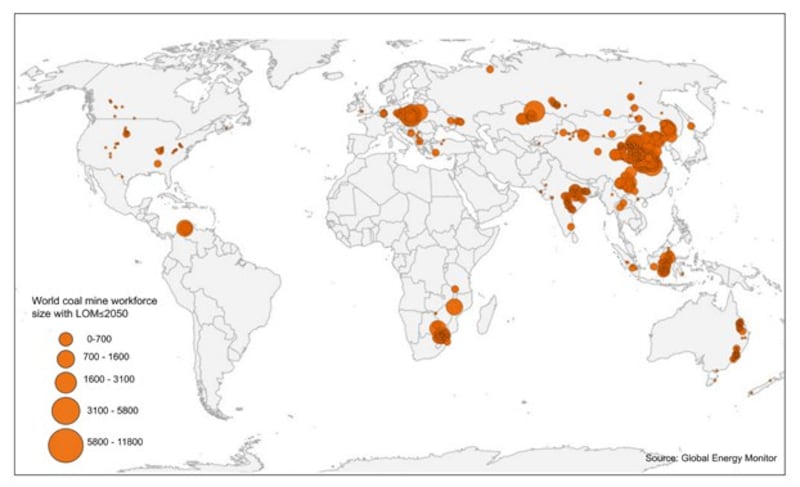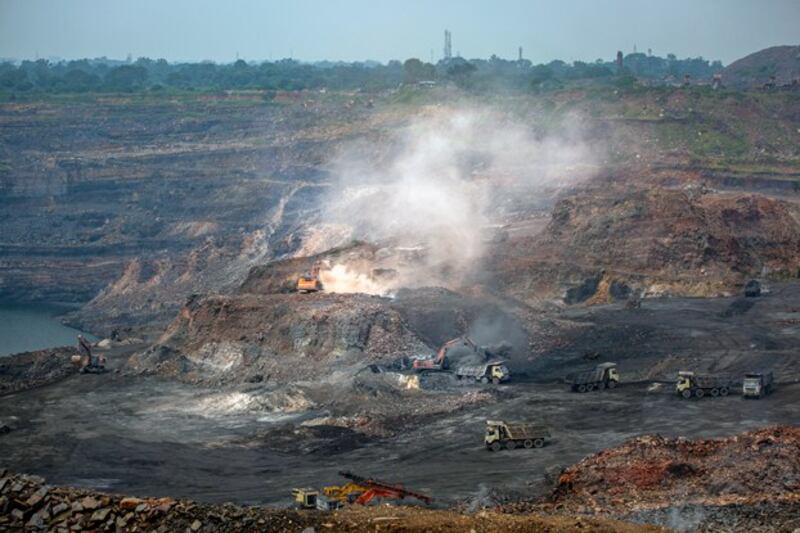In the bustling hot city of Siliguri in northeast India, Jitendar Kumar spends his days breaking up and shifting cinder pieces at a coal depot.
The 30-year-old has been working for half his life with coal, a legacy he inherited from his father, who spent 40 years in Ranigunj, India’s first coalfield that traces back to 1774, in West Bengal.
“I also started there but later chose the city over the mines,” Kumar said. “Like many here, coal puts food on our table. I don’t know what else to do.”
India, the world’s second-largest coal producer, has around 337,400 miners in its active mines. Labor activists estimate that this number could quadruple when accounting for informal workers in the sector.
This week, a new report said state-owned Coal India, the world’s largest government-owned coal producer, is facing the biggest potential layoffs of 73,800 direct workers by 2050.
Globally, close to a million coal mine jobs, or more than a third of the coalmining workforce, could vanish by 2050, with the vast majority of these losses expected in Asia, especially in China and India, the U.S.-based think tank Global Energy Monitor (GEM) said.
That means, on average, 100 coal miners a day could face job cuts as the coal industry winds down due to a market shift towards cheaper renewables and planned mine closures, it said.

Nearly half a million workers may lose their jobs before 2035, GEM said. The drop in employment, the think-tank added, will likely occur irrespective of particular coal phase-out strategies or climate action since such shifts are probably inevitable due to the market’s inclination towards more economical wind and solar energy options.
In Asia, more than 2.2 million people work in coal mines, according to GEM, with China leading the way.
China is home to over 1.5 million coal miners, responsible for generating more than 85% of the nation’s coal. This represents half of the global coal production. It is followed by India and Indonesia.
GEM said Indonesia, with about 160,000 coal mine workers, is expected to boost production enough to rival India’s output for the first time next year.
The non-government research organization said that China’s Shanxi province alone will likely lose about a quarter million mine jobs by midcentury.
The projections are based on data from the Global Coal Mine Tracker, which offers live information about 4,300 active and proposed coal mines globally, accounting for over 90% of the world’s coal production.
“Coal mine closures are inevitable, but economic hardship and social strife for workers is not,” said Dorothy Mei, project manager for the Global Coal Mine Tracker at Global Energy Monitor.
“Viable transition planning is happening, like in Spain where the country regularly reviews the ongoing impacts of decarbonization,” she said, adding that governments should learn from its success to plan their own “just energy transition strategies.”
To limit global warming to 1.5 degrees Celsius under the Paris Agreement’s guidelines, GEM estimates that only 250,000 coal miners would be needed. This is less than 10% of the current workforce.
Economic impact
Coal mine jobs also greatly influence local economies. Mining towns often depend heavily on coal companies for wages, taxes, and even schools or hospitals.
Past job losses from the 1980s and 1990s bankruptcies had led to economic distress, and future job cuts could have similar effects.
The workers deserve a “just transition” to new employment sectors, particularly those offering well-compensated positions in the clean and renewable energy domain, GEM said.

In 2016, China’s Ministry of Finance introduced the Industrial Special Fund, designating US$14 billion for the reemployment of 1.8 million workers in the coal and steel industries.
However, with each person estimated to get just over US$6,887, GEM said the fund’s sufficiency is debatable.
China Energy, the nation’s leading mining and energy firm, is among the country’s top five renewable energy investors.
With renewables making up 28.5% of its capacity and coal at 72%, the company aims to boost clean energy to over 50% by 2025, aligning with government goals.
Chance for sustainable future
Following a year marked by devastating mining accidents, significant labor disputes, and public opposition to mining activities, it is essential that coal miners be provided the chance to seek a safer and more sustainable future, GEM said in the report.
Hundreds of workers died from underground blasts, tunnel collapses, and equipment mishaps in mines worldwide.
At least six people were killed when a significant section of the pit wall at the Axla League coal mine in China crumbled in February, with 47 others still missing.
The China Labor Bulletin, an NGO monitoring work-related accidents in China, recorded 69 coal mine-associated incidents and fatalities in 2022, with 23 reported in the current year.
“The coal industry, on the whole, has a notoriously bad reputation for its treatment of workers,” said Ryan Driskell Tate, GEM’s program director for coal.
“What we need is proactive planning for workers and coal communities ... so industry and governments will remain accountable to those workers who have borne the brunt for so long.”
Edited by Taejun Kang and Elaine Chan.
